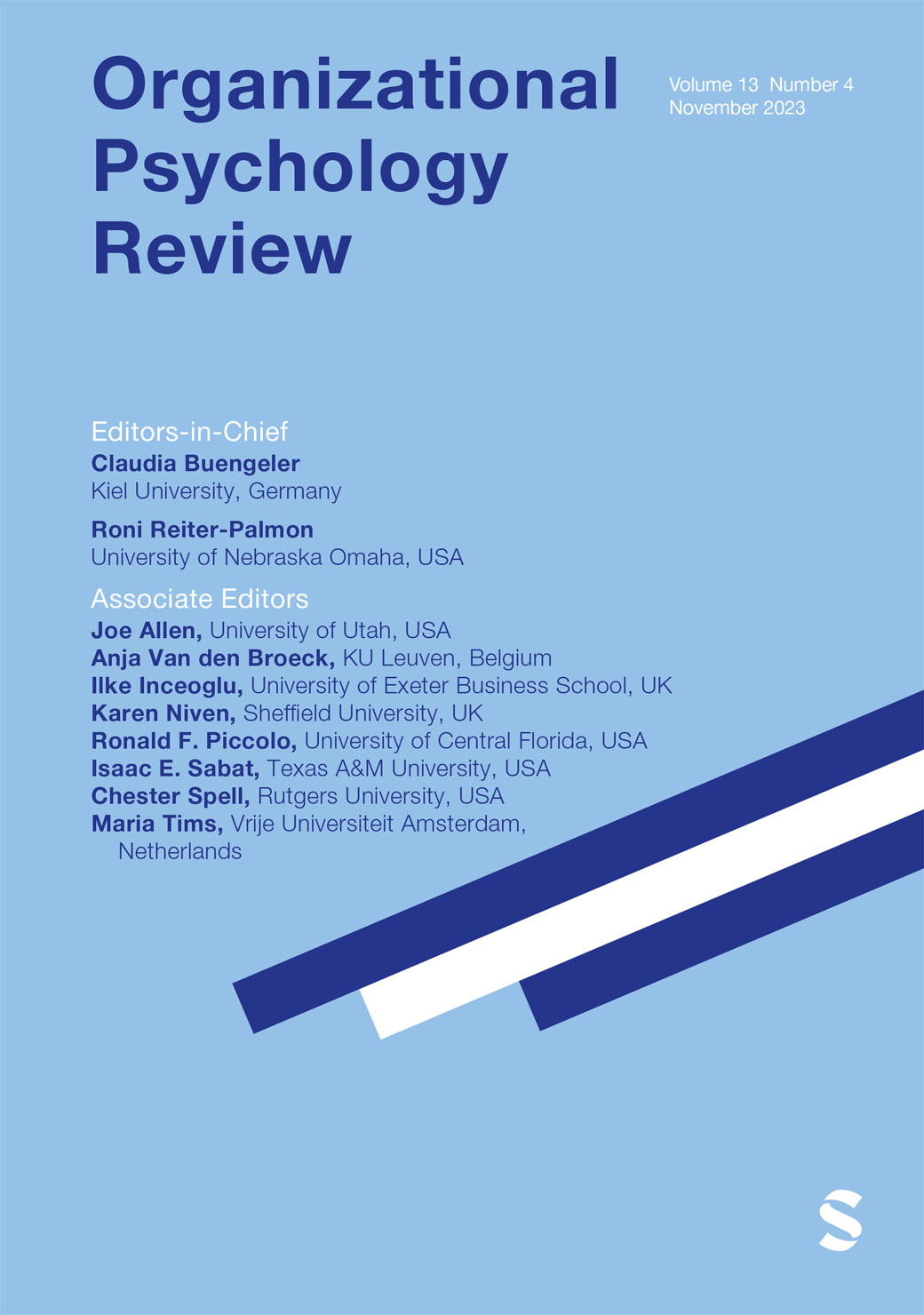When and why does status threat at work bring out the best and the worst in us? A temporal social comparison theory
IF 7.1
1区 心理学
Q2 MANAGEMENT
引用次数: 1
Abstract
This paper seeks to explain when and why people respond to status threat at work with behaviors oriented toward either self-improvement or interpersonal harming. To that end, we extend the established static social comparison perspective on status threat. Specifically, we introduce the notion of temporal proximity of status threat, which is informed by five temporal social comparison markers. We argue that people construe distal future status gaps as a challenge (and thus show self-improvement-oriented responses), but construe a more proximal status gap as a threat (and thus engage in negative interpersonal behaviors). Further, we introduce three factors of uncertainty that may render the underlying temporal comparison less reliable, and thereby less useful for guiding one's response. Overall, our temporal social comparison theory integrates and extends current theorizing on status threat in organizations by fully acknowledging the dynamic nature of social comparisons. Plain Language Summary Employees often compare themselves to others to evaluate their status. If they perceive that their status is at threat or risk losing status, they engage in behaviors to prevent status loss. These behaviors can be positive, aimed at improving one's position or they can be negative, aimed at harming others. This paper develops a theoretical framework to examine when employees engage in more challenge- vs. threat-oriented behaviors. We argue that an important question how employees react to status threat is its temporal proximity—will an employee's status be threatened in the near versus distal future? We propose that the more distal (vs. proximate) the status threat is, the more employees gravitate towards challenge- and less threat-oriented behaviors. But how do employees know when a status threat occurs in the future? We argue that employees will compare their past status trajectories to co-workers’ status trajectories to mentally extrapolate the temporal proximity of such a threat. More specifically, we propose five characteristics (temporal markers) of social comparison trajectories that inform employees about the temporal proximity: their relative current position, the relative velocity and acceleration of their status trajectory, their relative mean status level, and their relative minimum and maximum status. Moreover, we suggest that employees’ conclusions from these markers are weakened by uncertainty in the “data stream” of social comparison information over time, that is, the length of the time span available, the amount of interruptions in this data stream, and the number of fluctuations in their own and others’ status trajectories.什么时候以及为什么工作中的地位威胁会激发我们最好的一面和最坏的一面?时间社会比较理论
本文试图解释人们在工作中对地位威胁的反应何时以及为什么是以自我完善或人际伤害为导向的行为。为此,我们扩展了关于地位威胁的静态社会比较视角。具体来说,我们引入了地位威胁的时间接近性的概念,这是由五个时间社会比较标记提供的。我们认为,人们将遥远的未来地位差距视为一种挑战(从而表现出以自我改善为导向的反应),但将更近的地位差距视为由一种威胁(从而参与消极的人际行为)。此外,我们引入了三个不确定性因素,这三个因素可能会使潜在的时间比较不那么可靠,从而对指导一个人的反应不那么有用。总的来说,我们的时间社会比较理论通过充分认识社会比较的动态性质,整合并扩展了当前关于组织中地位威胁的理论。简明语言摘要员工经常将自己与他人进行比较,以评估自己的地位。如果他们意识到自己的地位受到威胁或有失去地位的风险,他们就会采取行动防止地位丧失。这些行为可以是积极的,旨在改善自己的地位,也可以是消极的,旨在伤害他人。本文提出了一个理论框架来考察员工何时参与更具挑战性和威胁性的行为。我们认为,员工如何应对地位威胁的一个重要问题是其时间上的接近性——员工的地位在近期和远期会受到威胁吗?我们提出,地位威胁越远(相对于接近),员工就越倾向于挑战性和较少威胁性的行为。但是,员工如何知道未来何时会出现身份威胁呢?我们认为,员工会将他们过去的状态轨迹与同事的状态轨迹进行比较,以在心理上推断这种威胁的时间接近程度。更具体地说,我们提出了社会比较轨迹的五个特征(时间标记),这些特征告知员工时间接近度:他们的相对当前位置、他们的状态轨迹的相对速度和加速度、他们的相对平均状态水平以及他们的相对最小和最大状态。此外,我们认为,随着时间的推移,社会比较信息的“数据流”中的不确定性削弱了员工从这些标记中得出的结论,即可用时间跨度的长度、数据流中的中断量以及他们自己和他人状态轨迹的波动次数。
本文章由计算机程序翻译,如有差异,请以英文原文为准。
求助全文
约1分钟内获得全文
求助全文
来源期刊

Organizational Psychology Review
Multiple-
CiteScore
10.00
自引率
1.60%
发文量
25
期刊介绍:
Organizational Psychology Review is a quarterly, peer-reviewed scholarly journal published by SAGE in partnership with the European Association of Work and Organizational Psychology. Organizational Psychology Review’s unique aim is to publish original conceptual work and meta-analyses in the field of organizational psychology (broadly defined to include applied psychology, industrial psychology, occupational psychology, organizational behavior, personnel psychology, and work psychology).Articles accepted for publication in Organizational Psychology Review will have the potential to have a major impact on research and practice in organizational psychology. They will offer analyses worth citing, worth following up on in primary research, and worth considering as a basis for applied managerial practice. As such, these should be contributions that move beyond straight forward reviews of the existing literature by developing new theory and insights. At the same time, however, they should be well-grounded in the state of the art and the empirical knowledge base, providing a good mix of a firm empirical and theoretical basis and exciting new ideas.
 求助内容:
求助内容: 应助结果提醒方式:
应助结果提醒方式:


